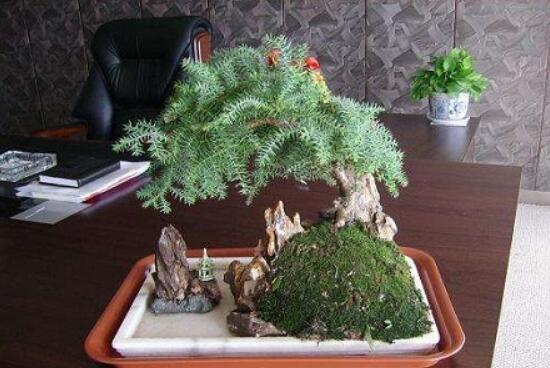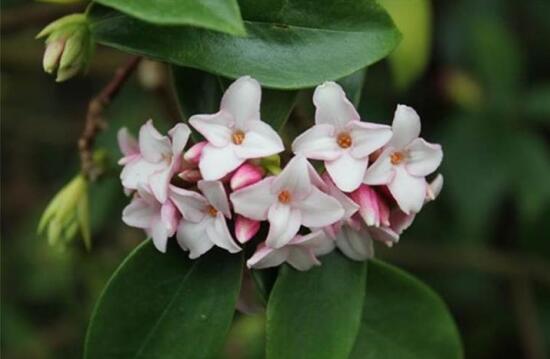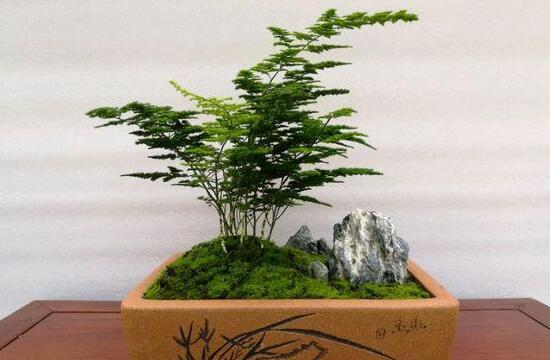Australian fir bonsai how to trim, Australian fir pruning methods / three tricks to create a perfect shape
Australian fir, a kind of evergreen, beautiful plant, it is often made into bonsai to keep indoors, not only good decoration effect, but also good air purification effect! However, if you want Australian fir to look beautiful, in addition to daily maintenance, timely pruning is also very important. So, how to trim the bonsai of Australian cedar? Next, let's take a look at the pruning methods of Australian fir.
First, how to trim the bonsai of Australian fir

When raising Australian fir indoors, it is inevitable to prune it. As for how to prune Australian fir bonsai, there are three simple tricks: shortening (truncating longer branches), thinning (cutting dry, overdense branches), and tillering (cutting off new branches regenerated near the roots). As long as we follow the method, we can create a perfect Australian fir bonsai shape.
2. Pruning methods of Australian fir (1) pruning time
How to trim Australian fir bonsai? First of all, you should choose the right time, so that the damage to the plant can be minimized after pruning. In this regard, we must first understand the growth habits of Australian fir, its best growth temperature is 10-25 ℃, like astigmatism. So the pruning time can be chosen in the spring and autumn, the specific climate, we can choose a sunny noon.
(2) pruning skills
1. Truncation
In the case of water, fertilizer and light, Australian fir will grow crazily, and some branches will grow very quickly, which breaks the overall beauty of the plant. So how to prune Australian fir bonsai, the first step is to cut it short: cut off some of the branches in the process of growing.
Pruning effect: after shortening the Australian fir, it not only makes the plant type more hierarchical, but also stimulates its lateral buds to sprout quickly and grow new branches, so that the ornamental effect of Australian fir will be greatly improved.
2. Thinning cut
Many flower friends of Australian fir grow luxuriantly, but this also has drawbacks, the leaves inside can not receive light. So how to prune the Australian fir bonsai, the second step is to cut off the branches of the Australian fir from the bifurcation.
Pruning effect: after thinning, the branches of Australian fir will be distributed more evenly, which increases ventilation and light transmittance, which is beneficial to the rapid growth of branches and leaves of Australian fir.
3. Tiller removal
The beauty of Australian fir bonsai lies in its overall shape, with luxuriant branches in the upper part and concise trunk in the lower part. Sometimes, however, twigs or root tillers grow at the bottom of the trunk (plantlets formed by adventitious buds protruding from the roots). So how to prune Australian fir bonsai, the third step is to remove tillers: cut off all the growing branches or small plants near the roots.
(3) pruning matters needing attention
In addition to knowing the time and skills for pruning Australian cedar, we should also pay attention to two details:
1. The scissors for pruning must be sharp and smooth
2. When pruning, the scissors should have an oblique angle of 45 degrees with the branches, so that the cut will be much smaller, which is conducive to the healing of the wound.
How to grow Australian fir, how to prune bonsai
Australian fir is an evergreen tree, also known as Cunninghamia lanceolata. Australian fir can be placed in the living room, study, office, storefront and so on. It is one of the valuable interior decoration plants. The large Australian fir bonsai is powerful, and the small one also has its ingenuity. It can be selected and trimmed according to everyone's preferences. Below, the editor will share with you the relevant knowledge of how to grow Australian fir and how to trim Australian fir bonsai.
How to cultivate Australian fir-culture method of Australian fir
1. Soil: Australian fir is suitable for slightly acidic sandy loam with good drainage and rich humus. When potted, it is better to use the mixture of garden soil, rotten leaf soil and peat moss.
2. Watering: Australian fir should be watered more from spring to autumn, but avoid stagnant water in the basin. When drying at high temperature, spray water on the basin plant and the ground near it to cool and humidify. Water it in time. Don't wait until the soil is dry before watering. Since the end of autumn, watering is gradually reduced to enhance its cold resistance.
3. Lighting: Australian fir likes diffuse light and should be placed in a bright place in the shed. If it is kept in the dark for a long time, it should be moved to the sun every few weeks to make the thick green leaves maintain a beautiful color.
4. Temperature: the growing season is long, and the Australian fir can grow throughout the year except when the summer temperature exceeds 32 ℃.
5. Fertilization: fertilizer should be applied every 2 weeks in the growing season, and the compound fertilizer containing nitrogen and potassium is suitable. If the supply of fertilizer is insufficient, the branches and leaves are easy to turn yellow.
6. Insect diseases: there are few diseases and insect pests of Australian fir, and the harm of shell insects is more common in indoor maintenance. it can be controlled by spraying methophos, chlorpyrifos, machine EC and Guoguang scale, and the effect is good.
How to cultivate Australian fir-matters needing attention in culturing Australian fir
1. Summer and autumn are the growing periods. Potted plants can not only be placed in the vulva, but also in the ventilated place with light in the window. Avoid exposure to the hot sun above 35 ℃, and it is not suitable to put in shady places without light for a long time. In this way, the branches and leaves will be withered and yellow or grow too long, affecting the ornamental value.
2. In the process of growth, in order to avoid tilting the trunk to one side, it is appropriate to turn the pot once a half month to let the plant receive light evenly. In addition, the trunk of young trees is fragile and easy to bend, so it is appropriate to set up pillars to fix the trunk from the time of young trees. In order to prevent the plant from growing too tall, the pot should be changed every 2-3 years after the spring is warm. At ordinary times, we should pay attention to protect the lateral branches so as not to be damaged and affect the plant shape.
3. Under normal circumstances, Australian fir does not need to be pruned to allow it to grow naturally. The suitable temperature for growth is 10-25 ℃, and the overwintering temperature is above 5 ℃. Overwintering season, can give a certain amount of light, basin soil can not be too dry, sunny weather should also spray water to increase humidity.
How to trim Australian fir bonsai
1. Cut short. This pruning method is to cut off part of the overgrown branches of Australian fir in order to stimulate its lateral buds to sprout quickly and grow new branches to improve the visual effect of Australian fir viewing.
two。 Thinning and cutting. This pruning method is to cut off the branches of the Australian fir from the bifurcations, which can make the branches more evenly distributed, increase ventilation and light transmittance, and is conducive to the rapid growth of the internal branches of the Australian fir. This method is mainly to cut off dry branches and over-dense branches.
3. Tiller removal. This pruning method is to remove twigs or root tillers from the bottom of the Australian fir trunk or near the mountain pass, so as to prevent these tillers from affecting the overall appearance.
Finally, I would like to remind you that when pruning, you need to pay attention to the sharp and smooth scissors, and the scissors should be at an oblique angle of 45 degrees between the scissors and the branches, so that the cut will be smaller, which is conducive to the healing of the cut. New buds can grow quickly. If you want to inhibit the growth of too exuberant branches, you can choose the small buds of Australian fir as a cut, which can promote the growth of strong buds!
How to prune Australian fir leaves yellowing?
Australian fir is very tenacious, evergreen all the year round, and it is also one of the masters of air purification, so it is very suitable for long-term maintenance in the room with insufficient light, so do you know how to trim the Australian fir? What if the Australian fir leaves turn yellow? Next, let's tell you.
How to prune Australian cedar?
Australian fir pruning can choose to change pots at the same time in spring, and in April and May, you can prune appropriately according to your own hobbies, and you will soon see new leaves that are tender green, with high ornamental value. It doesn't hurt to water more during the growth period, and spray water to the leaf surface, the growth will be better. Fertilizer is mainly nitrogen fertilizer, both phosphorus and potassium fertilizer, flower market has inorganic compound fertilizer, or cake fertilizer can be used. Australian fir growth period about half a month to apply fertilizer, can also be 0.2% urea or potassium nitrate spraying leaves, can make the leaf color dark green.
What if the Australian fir leaves turn yellow:
1. Light violence leaves yellow summer sun exposure, mosaic yellow with macula (sunburn disease). It is necessary to spray water in time to cool down and increase humidity. Add a sunshade net to make the flowers grow normally.
two。 Too much fertilizer burns leaves yellow applies too much thick fertilizer, flowers can not absorb the roots to burn, can not absorb water, and flowers and leaves yellow wither and fall. Apply thin fertilizer once a week in summer, do not apply more thick fertilizer. If you apply too much fertilizer, you can water more to get rid of the fertilizer.
3. Lack of fertilizer leaves thin yellow lack of fertilizer flowers and leaves are yellow and thin, branches are slender and tender. Fertilizer should be applied immediately and it will be effective within a week. It can be fertilized on time to make the flowers grow normally and bloom more.
4. Alkali soaked leaf yellow due to long-term watering of potted flowers, saline alkali accumulated in the potted soil. In severe cases, there is an alkaline shell on the potted soil, which makes the flowers and leaves fall off. In particular, soil and water in the north contain alkali. The method is to replace the new soil or apply ferrous sulfate solution.
How often are Australian fir watered?
In the process of maintenance, how often the Australian fir is watered, which depends on the humidity of the basin soil. In summer, in general, watering twice a week is enough. The control of watering can be reduced once in winter than in summer.
Australian fir bonsai in spring to autumn, should be more watering, but avoid stagnant water in the basin. When drying at high temperature, spray water on the basin plant and the ground near it to cool and humidify. Water it in time. Don't wait until the soil is dry before watering. Since the end of autumn, watering is gradually reduced to enhance its cold resistance.
In summer, when the basin soil is semi-dry, you can water it once along the edge of the basin. If the weather is very dry, spray water around the Australian fir bonsai to increase the wetness of the air to create a humid and suitable environment.
Propagation methods of Australian fir:
Australian fir is propagated mainly by seeds, but cuttings can also reproduce offspring.
The main results are as follows: 1. The seedlings cultivated by sowing are strong and vigorous, so they are suitable for mass propagation. Generally from July to August, the newly collected seeds will first break the seed coat in order to promote germination, otherwise leaving the soil for a long time will easily cause the seeds to rot, and then sow the treated seeds in the sand bed, covering about 1.5 cm of fine sand. Under the condition of 25-28 ℃ and a certain humidity, it can germinate after about 2-3 weeks, and it can be planted immediately after germination.
2. When cutting, if you choose the main axis or overgrown branches as cuttings, it is easy to cause incorrect crown shape of the plant, which can only grow horizontally and affect the ornamental value. Cut the first 2-3 nodes of robust branches that are easy to root as cuttings, remove some leaves, soak them in clean water overnight, and then insert them into a sand bed based on coarse sand or vermiculite. Keeping the temperature of 20-25 ℃ and high air humidity, it can take root after about 3 months.
- Prev

How to raise Ruixiang flowers, the breeding methods and precautions of Ruixiang / like fertilizer and avoid stagnant water
Daphne flower, also known as romantic tree, its tree shape is natural and unrestrained, the color is small and white, and the flower is full of fragrance, it is a kind of flower loved by flower friends. Life kind, after knowing the Ruixiang flower, many people want to raise it, then how to raise the Ruixiang flower? The following are the breeding methods and matters needing attention of Ruixiang arranged by the editor.
- Next

How to raise Phyllostachys pubescens, culture methods and matters needing attention / like semi-shade environment
Dwarf asparagus, a variety of asparagus, just like its name, the plant is very short, but it has a beautiful tree shape and bright green color, so it is very ornamental indoors. In life, many people want to raise short asparagus, how to raise it? The following are the culture methods and matters needing attention of the dwarf asparagus arranged by the editor, which are very detailed.
Related
- Fuxing push coffee new agricultural production and marketing class: lack of small-scale processing plants
- Jujube rice field leisure farm deep ploughing Yilan for five years to create a space for organic food and play
- Nongyu Farm-A trial of organic papaya for brave women with advanced technology
- Four points for attention in the prevention and control of diseases and insect pests of edible fungi
- How to add nutrient solution to Edible Fungi
- Is there any good way to control edible fungus mites?
- Open Inoculation Technology of Edible Fungi
- Is there any clever way to use fertilizer for edible fungus in winter?
- What agents are used to kill the pathogens of edible fungi in the mushroom shed?
- Rapid drying of Edible Fungi

